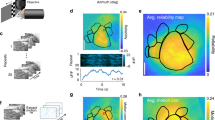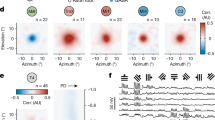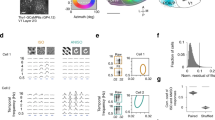Abstract
Humans and other animals generally perceive motion independently of the cues that define the moving object. To understand the underlying mechanisms of this generalization of stimulus attributes, we have examined the cellular properties of avian wide-field tectal neurons that are sensitive to a variety of moving stimuli but not to static stationary stimuli. This in vitro study showed phasic signal transfer at the retinotectal synapse and binary dendritic responses to synaptic inputs that interact in a mutually exclusive manner in the postsynaptic tectal neuron. A model of the tectal circuitry predicts that these two cellular properties mediate sensitivity to a wide range of dynamic spatiotemporal stimuli, including moving stimuli, but not to static stationary stimuli in a tectal neuron. The computation that is independent of stimulus detail is initiated by tectal neurons and is completed by rotundal neurons that integrate outputs from multiple tectal neurons in a directionally selective manner.
This is a preview of subscription content, access via your institution
Access options
Subscribe to this journal
Receive 12 print issues and online access
$209.00 per year
only $17.42 per issue
Buy this article
- Purchase on Springer Link
- Instant access to full article PDF
Prices may be subject to local taxes which are calculated during checkout






Similar content being viewed by others
References
Albright, T.D. Cortical processing of visual motion. in: Visual Motion and its Role in the Stabilization of Gaze (eds. Miles, F.A. & Wallman, J.) 177–201 (Elsevier, Amsterdam, 1993).
Croner, L.J. & Albright, T.D. Seeing the big picture: integration of image cues in the primate visual system. Neuron 24, 777–789 (1999).
Albright, T.D. Form-cue invariant motion processing in primate visual cortex. Science 255, 1141–1143 (1992).
Olavarria, J.F., DeYoe, E.A., Knierim, J.J., Fox, J.M. & VanEssen, D.C. Neural responses to visual texture patterns in middle temporal area of the macaque monkey. J. Neurophysiol. 68, 164–181 (1992).
Geesaman, B.J. & Andersen, R.A. The analysis of complex motion patterns by form/cue invariant MSTd neurons. J. Neurosci. 16, 4716–4732 (1996).
Jassik-Gerschenfeld, D. & Guichard, J. Visual receptive fields of single cells in the pigeon's optic tectum. Brain Res. 40, 303–317 (1972).
Frost, B.J., Cavanagh, P. & Morgan, B. Deep tectal cells in pigeons respond to kinematograms. J. Comp. Physiol. A 162, 639–647 (1988).
Frost, B.J. Subcortical analysis of visual motion: Relative motion, figure-ground discrimination and self-induced optic flow. in: Visual Motion and its Role in the Stabilization of Gaze (eds. Miles, F.A. & Wallman, J.) 159–175 (Elsevier, Amsterdam, 1993).
Luksch, H., Karten, H.J., Kleinfeld, D. & Wessel, R. Chattering and differential signal processing in identified motion sensitive neurons of parallel visual pathways in chick tectum. J. Neurosci. 21, 6440–6446 (2001).
Jassik-Gerschenfeld, D., Minois, F. & Conde-Courtine, F. Receptive field properties of directionally selective units in the pigeon's optic tectum. Brain Res. 24, 407–421 (1970).
Frost, B.J. & Nakayama, K. Single visual neurons code opposing motion independent of direction. Science 220, 744–745 (1983).
Frost, B.J. Moving background patterns alter directionally specific responses of pigeon tectal neurons. Brain Res. 151, 599–603 (1978).
Luksch, H., Cox, K. & Karten, H.J. Bottlebrush dendritic endings and large dendritic fields: motion-detecting neurons in the tectofugal pathway. J. Comp. Neurol. 396, 399–414 (1998).
Tömböl, T. & Németh, A. Direct connections between dendritic terminals of tectal ganglion cells and glutamate-positive terminals of presumed optic fibres in layers 4-5 of the optic tectum of Gallus domesticus. Neurobiology (Bp) 7, 45–67 (1999).
Karten, H.J., Cox, K. & Mpodozis, J. Two distinct populations of tectal neurons have unique connections within the retinotectorotundal pathway of the pigeon (Columba livia). J. Comp. Neurol. 387, 449–465 (1997).
Hunt, S.P. & Webster, K.E. The projection of the retina upon the optic tectum of the pigeon. J. Comp. Neurol. 162, 433–445 (1975).
Hardy, O., Leresche, N. & Jassik-Gerschenfeld, D. Morphology and laminar distribution of electrophysiologically identified cells in the pigeon's optic tectum: an intracellular study. J. Comp. Neurol. 233, 390–404 (1985).
Luksch, H. & Golz, S. Anatomy and physiology of horizontal cells in the optic tectum of the chick. J. Chem. Neuroanatomy 25, 185–194 (2003).
Chubb, C. & Sperling, G. Drift-balanced random stimuli: a general basis for studying non-Fourier motion perception. J. Opt. Soc. Am. A 5, 1986–2007 (1988).
Lu, Z.L. & Sperling, G. Three-systems theory of human visual motion perception: review and update. J. Opt. Soc. Am. A 18, 2331–2370 (2001).
Baker, C.L. Jr. & Mareschal, I. Processing of second-order stimuli in the visual cortex. Prog. Brain Res. 134, 171–191 (2001).
Rodieck, R.W. The First Steps in Seeing (Sinauer, Sunderland, Massachusetts, 1998).
Meister, M. & Berry, M.J. II. The neural code of the retina. Neuron 22, 435–450 (1999).
Tabata, T. & Kano, M. Heterogeneous intrinsic firing properties of vertebrate retinal ganglion cells. J. Neurophysiol. 87, 30–41 (2002).
Nalbach, H.O., Wolf-Oberhollenzer, F. & Remy, M. Exploring the image. in Vision, Brain, and Behavior in Birds (eds. Zeigler H.P. & Bischof, H.J.) 25–46 (MIT Press, Cambridge, Massachusetts, 1993).
Troy, J.B. & Lee, B.B. Steady discharges of macaque retinal ganglion cells. Vis. Neurosci. 11, 111–118 (1994).
Luksch, H. Cytoarchitecture of the avian optic tectum: neuronal substrate for cellular computation. Rev. Neurosci. 14, 85–106 (2003).
Frost, B.J., Scilley, P.L. & Wong, S.C.P. Moving background patterns reveal double-opponency of directionally specific pigeon tectal neurons. Exp. Brain Res. 43, 173–185 (1981).
Marin, G. et al. Spatial organization of the pigeon tectorotundal pathway: An interdigitating topographic arrangement. J. Comp. Neurol. 458, 361–380 (2003).
Revzin, A.M. Functional localization in the nucleus rotundus. in: Neural Mechanisms of Behavior in the Pigeon (eds. Granda, A.M. & Maxwell, J.H.) 165–175 (Plenum, New York, 1981).
Wang, Y. & Frost, B.J. Time to collision is signalled by neurons in the nucleus rotundus of pigeons. Nature 356, 236–238 (1992).
Sun, H. & Frost, B.J. Computation of different optical variables of looming objects in pigeon nucleus rotundus neurons. Nat. Neurosci. 1, 296–302 (1998).
Chichilnisky, E.J. & Kalmar, R.S. Temporal resolution of ensemble visual motion signals in primate retina. J. Neurosci. 23, 6681–6689 (2003).
Abbott, L.F., Varela, J.A., Sen, K. & Nelson, S.B. Synaptic depression and cortical gain control. Science 275, 220–223 (1997).
Tsodyks, M.V. & Markram, H. The neural code between neocortical pyramidal neurons depends on neurotransmitter release probability. Proc. Natl. Acad. Sci. USA 94, 719–723 (1997).
Chance, F.S., Nelson, S.B. & Abbott, L.F. Synaptic depression and the temporal response characteristics of V1 cells. J. Neurosci. 18, 4785–4799 (1998).
Goldman, M.S., Maldonado, P. & Abbott, L.F. Redundancy reduction and sustained firing with stochastic depressing synapses. J. Neurosci. 22, 584–591 (2002).
Freeman, T.C.B., Durand, S., Kiper, D.C. & Carandini, M. Suppression without inhibition in visual cortex. Neuron 35, 759–771 (2002).
Carandini, M., Heeger, D.J. & Senn, W.A Synaptic explanation of suppression in visual cortex. J. Neurosci. 22, 10053–10065 (2002).
Chung, S., Li, X. & Nelson, S.B. Short-term depression at thalamocortical synapses contributes to rapid adaptation of cortical sensory responses in vivo. Neuron 34, 437–446 (2002).
Cook, D.L., Schwindt, P.C., Grande, L.A. & Spain, W.J. Synaptic depression in the localization of sound. Nature 421, 66–70 (2003).
Lettvin, J.Y., Maturana, H.R., McCulloch, W.S. & Pitts, W.H. What the frog's eye tells the frog's brain. Proc. IRE 47, 1940–1951 (1959).
Palanca, B.J.A. & DeAngelis, G.C. Macaque middle temporal neurons signal depth in the absence of motion. J. Neurosci. 23, 7647–7658 (2003).
Newsome, W.T., Britten, K.H. & Movshon, J.A. Neuronal correlates of a perceptual decision. Nature 341, 52–54 (1989).
Croner, L.J. & Albright, T.D. Segmentation by color influences responses of motion-sensitive neurons in the cortical middle temporal visual area. J. Neurosci. 19, 3935–3951 (1999).
Wilson, H.R. The role of second-order motion signals in coherence and transparency: higher-order processing in the visual system. Ciba Foundation Symposium 184, 227–244 (1994).
Orger, M.B., Smear, M.C., Anstis, S.M. & Baier, H. Perception of Fourier and non-Fourier motion by larval zebrafish. Nat. Neurosci. 3, 1128–1133 (2000).
Roeser, T. & Baier, H. Visuomotor behaviors in larval zebrafish after GFP-guided laser ablation of the optic tectum. J. Neurosci. 23, 3726–3734 (2003).
Demb, J.B., Zaghloul, K. & Sterling, P. Cellular basis for the response to second-order motion cues in Y retinal ganglion cells. Neuron 32, 711–721 (2001).
Hellmann, B. & Güntürkün, O. Structural organization of parallel information processing within the tectofugal visual system of the pigeon. J. Comp. Neurol. 429, 94–112 (2001).
Acknowledgements
The authors thank H.J. Karten and D. Kleinfeld for support during the collection of preliminary data, A. Mahani for comments and W.B. Kristan, H. Wagner, G. DeAngelis, M. Ariel, P. Lukasiewicz, J. Sanes and A. Carlsson for critical reading of the manuscript. The work was supported by grants from Deutsche Forschungsgemeinschaft to H.L. and Whitehall Foundation and McDonnell Center for Higher Brain Function to R.W.
Author information
Authors and Affiliations
Corresponding author
Ethics declarations
Competing interests
The authors declare no competing financial interests.
Rights and permissions
About this article
Cite this article
Luksch, H., Khanbabaie, R. & Wessel, R. Synaptic dynamics mediate sensitivity to motion independent of stimulus details. Nat Neurosci 7, 380–388 (2004). https://doi.org/10.1038/nn1204
Received:
Accepted:
Published:
Issue Date:
DOI: https://doi.org/10.1038/nn1204
This article is cited by
-
Motion processing with wide-field neurons in the retino-tecto-rotundal pathway
Journal of Computational Neuroscience (2010)
-
Generating oscillatory bursts from a network of regular spiking neurons without inhibition
Journal of Computational Neuroscience (2009)
-
Distributed delays stabilize neural feedback systems
Biological Cybernetics (2008)
-
Sparse Spatial Sampling for the Computation of Motion in Multiple Stages
Biological Cybernetics (2006)



